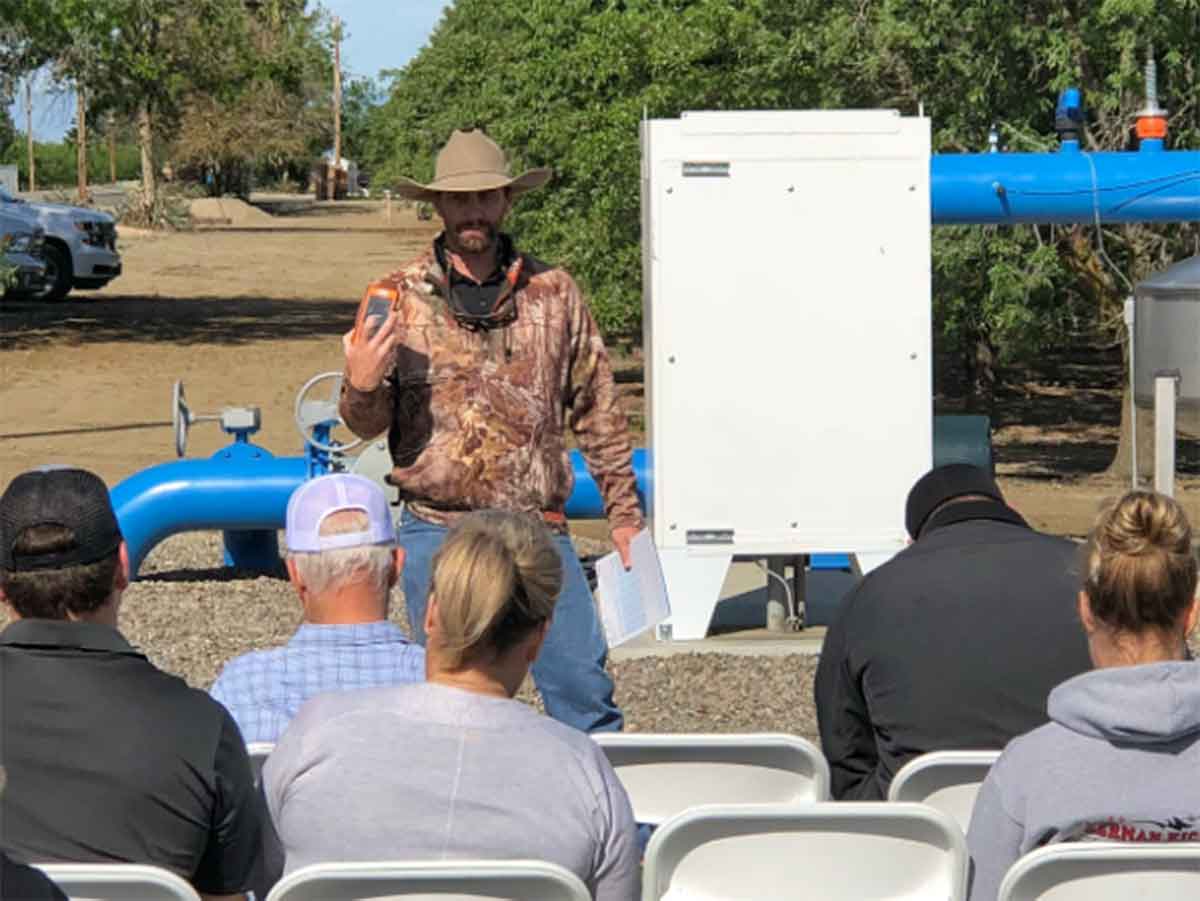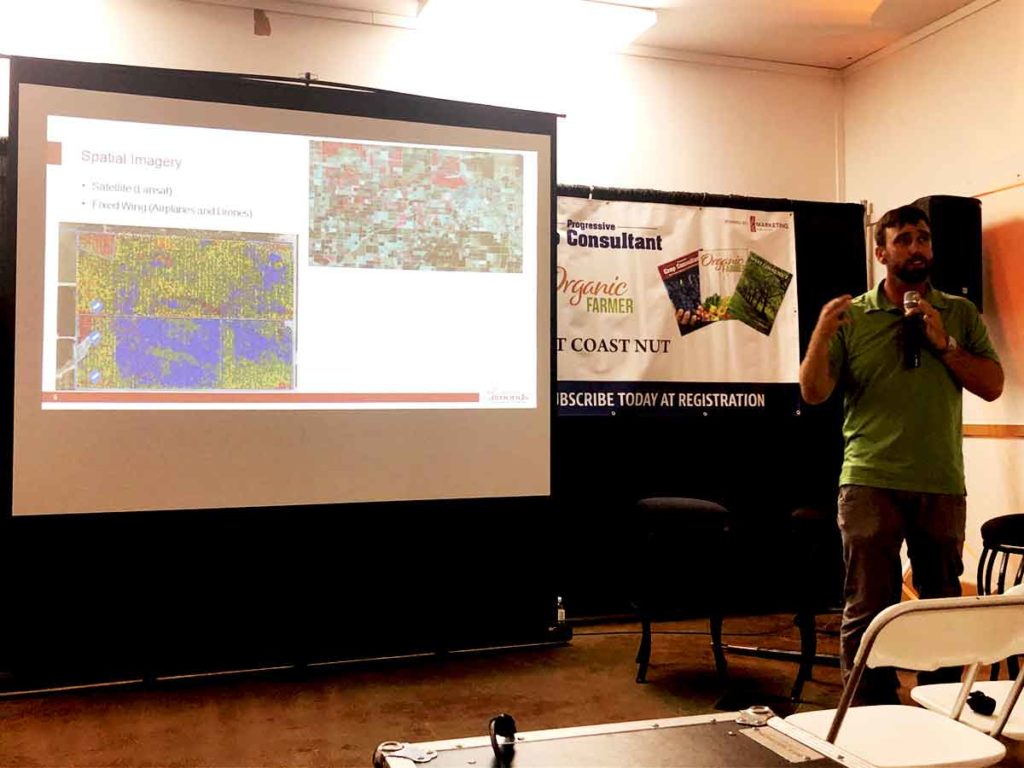
All farmers use technology in their orchards.This includes technology as it applies to—and continues to shape—irrigation. Agriculture has seen some incredible changes since the ancient peoples diverted flood waters into their fields in 6000 B.C., and the shifts in technology allow today’s farmers to know far more about what is happening in the soil, the trees, and with the water.
When drip irrigation was invented in 1960, the irrigation and farming industries were transformed. In the 1970s, neutron probes appeared on the market and created yet another step for irrigation and farming. With the need to know more about what was happening in the dirt, soil moisture sensors and telemetry in the field became tech-of-the-day in the 1990’s and early 2000’s, where the devices were hardwired to your barn through a telephone landline.
It wasn’t without its problems, and early adopters of this tech were more harmed by it than helped. When the technology actually caught up to where it needed to be, it was difficult for growers to adopt it, let alone trust it.
Soil sensors and telemetry now have an assortment of new gadgets and apps, making the user experience and the user interface of this technology more economical and easier to follow. These upgrades are nice, but the science behind the technology itself, however, hasn’t changed much over the last 10 years.
Keeping Pace with Tech
The speed at which technology happens outside of the agricultural landscape is quite fast. This is why it’s important to ask questions of the companies providing services to the Ag industry, to inquire where they themselves are headed in regards to tech, and to see if they are looking forward into where you, as a farmer, are headed with your operations. It comes down to finding how the technologies developing today fit into these operations.
There’s a focus on automated plant sensing, with a special look at technology that works in conjunction with orchard water requirements, irrigation system performance, and applied water, soil moisture, and plant water status.
Spatial Tech-based Monitoring
These days, satellite spatial technologies—such as Google Earth, developments from NASA, other satellite imagery—and fixed-wing tools, such as airplanes and drones, have allowed farmers to take a step back—way back—and see their orchards from an aerial view.
As far as satellite technology, looking at images is about all a grower can do. Commonly available LandSat satellite images are created every 16 days, and only measure down to a 30m x 30m plot. The resolution leaves much to be desired, and because of these drawbacks, satellite imaging can be difficult to incorporate into irrigation management.
What are working at far better speeds and resolutions are airplanes and drones. These two options allow a grower to see the trees and identify any irrigation issues. Drones can provide a far more accurate tree count, identify dead or damaged trees in the orchard, and other data that comes with nearly immediate supervision of an orchard. This can include helping with irrigation infrastructure issues.
Weather-based Monitoring
ET Monitors
With innovations in rootstocks and varieties, the resulting trees and canopies are larger and require more water. With the overall transition to water consciousness, the upcoming Sustainable Groundwater Management Act (SGMA) requirements, and other water-related issues, university research has begun taking a much closer look at evapotranspiration (ET). ET is the combination of soil or water evaporation and plant transpiration—two processes that transfer moisture from the land to the atmosphere.
Special towers were placed in orchards and use the eddy covariance methodology for determining the crop’s ET. Once the towers calculate the ET, the figure is used to develop a correct crop coefficient, which helps determine the amount of water a tree will use. This research is done about every five years.
Currently, these towers are for research only, and come at a price tag that isn’t conducive for growers. To remedy this, a Ph.D. student and researcher at University of California, Davis was asked to devise a way to make this affordable for growers.
Surface Energy Balance
The new tech hit the commercial market in 2015-16. Already a tool used by wine grape growers, the industry knew that if the technology was going to shift to almonds, it had to work as well and as effectively. Almond Board of California has spent the last few years researching the technology in order to validate whether or not it works, and to see where the tech’s strengths and weaknesses might lie.
Using a tiny thermocouple sensor and local weather conditions, a surface energy balance measures the amount of energy that is lost either through evaporation from the soil or transpiration from the crop. It’s a great technology for growers to get on par with ET data. Some complementary steps would have to be taken for first- or second-leaf orchards, as this technology can’t differentiate between evaporative environmental losses or transpirative losses from the plant in trees that young. Ground truthing and soil moisture sensing help with this. The weekly farm advisory report offers an estimate in terms of these figures, but the surface energy balance gives growers something more accurate for their particular orchard.
Plant-based Monitoring
Pressure Chambers/Pressure Bombs
Pressure chambers—or pressure bombs—are devices that use air pressure to determine how much tension a leaf is experiencing on its water. This tension can come from things such as dry soil, or when the roots can’t replenish moisture as quickly as it evaporates from the leaves. A useful technology, this system requires more hands-on labor to determine the state of the tree.
Another big downfall to pressure chambers is the inability to track data trends. The most powerful tool in data collection is the recording of trends, as they show what has happened over time, and what has caused any differences.

Dendrometers
Dendrometers are a tool that can give real-time reporting on how a tree is reacting to a certain kind of irrigation. Measuring the shrink and swell of growth, whether fruit or trunk diameter, dendrometers allow a way to look at growth patterns.
This technology actually shows that a tree struggles a bit when farmers saturate and create anaerobic conditions or over irrigate. The tree shuts down for a while, and after a day or two or allowing the soil to dry, the tree behaves as if it can “breathe” again.
Dendrometers help give perspective to how the tree is feeling in terms of water stress. However, growers should be aware that dendrometers do have a flaw if used in conjunction with full-coverage irrigation. Since this type of irrigation wets the trees, dendrometers could misinterpret the growth and shrinkage of the trunk due to swelling caused by water hitting the tree. If this is the case, a grower should work with their provider to make sure that they are getting accurate data.
Flow Sensors
Currently in the development stage, these sensors consist of, for lack of a better term, a “pressure switch” that is inserted into the tree and measures how hard a tree must work to pull moisture into itself. While a few growers have been modeling this system, and it seems to be pretty accurate for almonds and wine grapes, sensitivity issues with the device at lower thresholds have currently delayed the use of this technology in walnuts. This device is not yet available commercially, but its intent is to not only provide and track data, but to eliminate the labor required in using pressure chambers.
Soil Auger
Sometimes the best technology is the simplest. A soil auger can get three feet down into the dirt in just a few minutes, allowing growers to see what’s happening in the soil at multiple locations.
Plan Implementation
No matter how high-tech the newest innovations might be, if growers are not out in the orchards and don’t know what’s going on deeper than six inches beneath the dirt, the investment of time and money simply won’t be worth it, nor will aggravation or lost enthusiasm for the industry’s innovations.
Ultimately, it’s about the integration of new technologies with one another, as well as with the orchard. The selection of one technology over another isn’t the goal, but rather how individual growers will build and form a platform that best suits their needs.
If you are unfamiliar with the technology coming out, construct a three-to-five year plan for implementation and look at as much as you can of what the market offers. Be open to new technology and build on it to move your orchard and operations forward in the most effective way.
Special thanks to Spencer Cooper at Almond Board of California.










